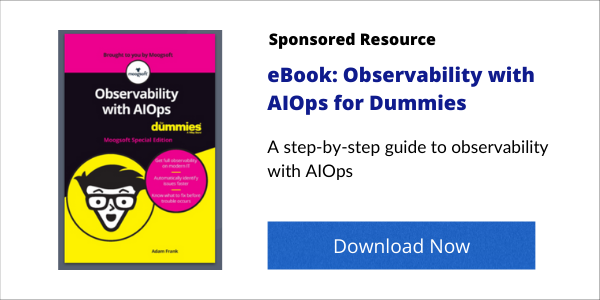
Observability with enterprise IT systems is critical in an age of digital transformation.
As organizations embrace digital transformation, the associated automation of business processes has ramped up pressure on IT teams to be more proactive and flexible. There is unusual focus on DevOps practitioners and site reliability engineers (SREs), for these are the professionals who create the critical apps and keep them running. Rapid, informed response is vital because a digitally transformed business lives or dies on the performance of its operational systems.
The built-in complexity of modern systems and vast operational data volumes has produced a new associated challenge. When something goes wrong and performance takes a hit, legacy manual processes of discovering probable root cause and remediation are too slow. As a result, the new essential tool for operational teams is observability.
Featured Resource: Observability with AIOps For Dummies [Download Now]The need for observability
Observability is the modern way for teams to use operational data as a Rosetta stone that clearly shows the internal states of all system elements and contextual relationships to each other. Observability is your friend 24×7 because when a business process stops working, algorithms use your data to quickly inform teams exactly what went wrong – and why. Then, observability guides you to the right steps for remediation so you can get systems back up and running ASAP.
The requirement for observability starts with development of modern applications. The creation, deployment and continuous iteration of business apps needs observability because they are integrally tied to all stacks of the enterprise IT environment.
For this reason, development teams often drive for change in the dynamics and role of the IT department. The work of DevOps practitioners and SREs can no longer be seen as just a back-end function. DevOps and SREs must be proactive, especially when that function directly ties to generation of revenue.
Let’s consider three significant changes for DevOps practitioners and SREs.
Agility. DevOps is all about speed. The broad adoption of agile development practices accelerates the delivery of app creation and feature changes into the production environment.
Automation. DevOps has mostly automated the process of change delivery. As a result, the development process is much faster. So is delivery of results.
Integration. Since the work of DevOps practitioners and SREs touches all stacks of enterprise IT, it’s not surprising to find desegregation occurring with development and operations teams. Historically, the IT operations team has provided care of the environment and DevOps and SREs have managed development as two separate functions – often with different organizational reporting structures. In a modern environment, siloed functions are no longer practical. Typically they are now joined together in terms of practice, interaction, even sharing technology tools like observability.
Is there resistance to creating this Big Happy Family? Obviously! IT operations may resent the close interaction with development or view coding as a tiny cog in a giant wheel. Conversely, DevOps practitioners and SREs may not fully understand the difficulty in managing a vast production environment. From the outside, caring for production may seem like a relatively straightforward, low-level task. For a DevOps and SRE purebred, perspective on infrastructure can be myopic, focusing just on the specific patches of infrastructure that are relevant to any particular coding project.
If these attitudes exist in your modern environment, helping teams adjust behavior to new requirements should be Priority One. No modern app lives in isolation; it coexists with a complex ecosystem of shared IT resources. Likewise, collaboration of the caregivers for apps and environment is of the essence!

Leveraging observability tools and automation
Unity between DevOps practitioners, SREs and IT operations is not just about softening or breaking down siloed human interactions. Unity also entails the use of shar/ed observability tools that help everyone leverage the same operational data for accomplishing responsibilities in their respective job domains.
Let’s consider how automation feeds into this relationship. For DevOps and SRE teams, there are many steps to moving a new module or application from the development environment into the real-world production environment. Historically, these steps have mostly been manual. Now automation removes the toil by taking the human out of the process.
By using an observability solution with automation, the path from development to production can be executed in a smarter way.
For example, an observability solution may provide algorithms that automatically use data from the production environment to understand the current disposition of resources within that environment. Having this insight lets DevOps practitioners and SREs ensure that the new application or change being delivered has sufficient resources to support itself, while not colliding with or starving other applications for shared resources. All this is achievable with automation.
One stage for automation is the path from development to production. Observability tools for improving this path include pattern discovery, anomaly detection and causal analysis. The observability solution will automatically assess resource allocation and timing decisions around the delivery of new components into the production environment.
Another stage is continuous iterations of the app with new features and functionality. Software changes used to have languid debuts once a year, twice a year, maybe quarterly. With DevOps, changes are more like dozens, hundreds or thousands of times a week! Automated observability tools are essential.
Featured Resource: Observability with AIOps For Dummies [Download Now]Helping teams get control with observability
Modern apps have different and challenging characteristics; they are modular, ephemeral and highly distributed. Without observability, it’s impossible to predict with a high degree of certainty what the impact of a new change will be on a production environment.
Only an observability solution can rapidly analyze what the presence of a particular new element means, and quickly provide diagnostic insight back to DevOps practitioners, SREs and IT operations on how to resolve issues.
Due to vast operational data volumes from digital transformation, DevOps practitioners, SREs and IT operations teams are finding it virtually impossible to understand how the production environment is performing without using an observability tool. Without its smart filter, the development cycle becomes ponderous and teams find it challenging to apply action to negative events.
Observability will come to the rescue! As you strive to fade out silos and create organizational unity for a modern IT culture, be sure to evaluate shared observability options that cement unity of DevOps practitioners, SREs and IT operations teams. Observability is the foundation of operational control and reliable provision of high-performance services for the modern enterprise.






